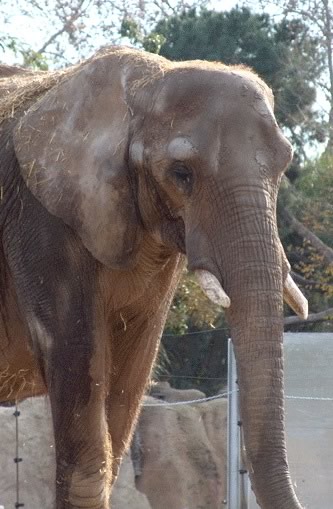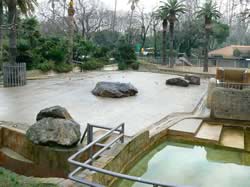|
Long term studies on wild elephants show that these animals thrive in extensive social networks in large, complex ecosystems. By contrast, the majority of elephants in zoos are frequently separated from their relations and companions and are subjected to unsuitable climates and insufficient space. Many also face invasive reproductive and health measures, as well as the practice of chaining and physical control and discipline. "Elephant parks" should replace traditional zoosThe frequent occurrence in zoos of foot and weight-related diseases, arthritis, still-births, infertility, infanticide, heightened aggression, stereotypic swaying and head bobbing, and other neurotic behaviour, is a good indication that elephants' needs are not being met. The misery suffered by many elephants in zoos is inexcusable, and there is mounting pressure for major changes to be adopted in the way that these individuals are kept. We advocate that old-fashioned elephant exhibits be phased out. A growing number of "good" zoos now provide several acres for their elephants. This is a big step in the right direction. We recommend moving extant elephants to even larger "Elephant Parks" on the order of squares of kilometers. As discussed in our chapter, Poole, J & Granli, P. 2008. Mind and Movement: Meeting the Interests of Elephants. (2.19 MB), such parks would give individuals the kind of space and autonomy that elephants need to live a decent life. A small number of these elephant parks could be constructed in the milder climatic zones of Europe and North America, to accomodate relatively natural social (several families and adult males) and environmental settings (natural forage). These elephant parks could be run either privately or by progressive zoo associations and accommodate elephants who are currently in traditional zoo settings. Alternative elephant exhibits without elephants future solutionIn an ideal world there would be no elephants held captive in zoos. Live elephants would be replaced by advanced, interactive, virtual reality elephant exhibits, where people learn why elephants shouldn't be kept in confinement. Multimedia theaters and web cameras would allow the public to view documentary films, and to follow wild elephants in their natural environment. By partnering with field studies in such an endeavor, zoos would be able to meet educational and conservation goals. We believe that as the plight of captive elephants is better understood by a discerning public, depressed and dysfunctional zoo elephants will become increasingly unacceptable, and there will be broad demand and appeal for alternative exhibits. ElephantVoices' standpoint is that elephants require complex social and environmental settings to thrive; to meet the interests of elephants zoos need to start thinking on the order of square kilometers. Or, as an even better alternative, zoos can offer high-end virtual educational exhibits that through animatronics and multimedia connect the public to the capabilities and lives of wild elephants, while stimulating the interest in their conservation. |
An obsolete exhibit exemplified by the Barcelona Zoo in 2009, home to lonely Susi, who has spent her life standing on concrete under the hot Spanish sun, or in her 24 sq.m basement stall. With no companions, nothing to do and nowhere to go, listless Susi was losing weight and covered in calluses from lying on concrete. Under pressure, the zoo brought in female, Yoyo, housing the two in the underground bunker while they dug up the concrete and increased the exhibit from a pathetic 1,000 sq.m to meagre 1,600 sq.m. You will find an update about Barcelona Zoo and their elephants from June 2010 here.
|
Stereotypic behavior - typical consequence of captivity for elephants (Footage: ElephantVoices)




